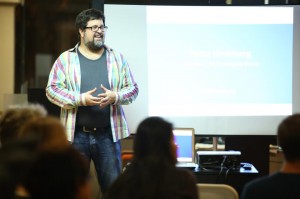Brainjams in Berkeley was quite an exercise with ‘free radicals’! Don’t worry though, no one was the worse for wear afterwards, and the 20+ folks who joined us at Jupiter Pizza afterwards did quite well shutting their Brains Off…
As with most events we have held so far, we have tried to experiment a bit with different formats, to learn what works and what does not. Despite learning quite a bit from what did not work out as I had hoped, participants generally felt the event was a success and the value of the conversations we all had was fairly high. There was some particularly useful insytes shared on the topic of collaboration and I was fortunate to get some great advice on the future of BrainJams from David Allen, Cathryn Hrudicka, Dave Burleigh, Kristie Wells, Dan Genova, Shannon Clark, Bill Allison and Rachel Murray.
It was this discussion that lead to the idea that we should focus BrainJams on serving the needs of people who belong to multiple groups or cliques – the boundary spanners, or primary hubs of the attention economy. Dave Burleigh referenced this as becoming the SIG of SIG’s, but I really think it is more about developing the meta-layer for detailing the social fabric of group to group collaboration. Peer to peer collaboration may be the big thing today, but group to group (G2G) collaboration and networking is an area that deserves more understanding. In striving for diversity in an open community such as BrainJams, it just makes sense that we want people who are not self-identifying as only a ‘geek’ or only a ‘marketing guy’ or only an ‘artist’ – from my personal experience with several large organizations, it was these people who got the real work done inside the organization, so it follows that these are the people who can get the real work done ACROSS organizations.
At the end of the day, I was fortunate to chat with Angela Hunter and Wayne Caplinger. Angela drew a parallel between what Lee Felsenstein and the Homebrew Computer Club did for computers and what BrainJams is trying to do for ad-hoc collaboration using the best insights available. She referenced the idea of having BrainJams serve as a “Grassroots ThinkTank” which I find insightful. This directly parallels the power/access issues that was at the root of the need for Homebrew in that the people on the inside often disregarded the people on the outside as amateurs with little to contribute. But then, as now, we know this to be far from truth. The collective wisdom is much greater than that of those in the ivory towers – you and I have much to contribute, though the systems and power laws are not designed to easily enable such contributions. That is why we must take this matter into our own hands and figure out the systems and tools we really need in order to raise awareness of the most valuable insytes and knowledge, from the widest swath of experience possible.
With the enthusiasm for collaboration and sharing knowledge clearly expressed by other participants, and a desire to bring about positive social change within all areas of our lives, it would seem that “The Noble Pursuit” is more relevant than ever. Perhaps this is really what it is all about – not just people getting together for an unconference of XYZ, but really mapping out the people, tools, processes, groups and other elements in a way that truly makes it easy for people who want to create positive change within their corporations and across society to find out what they need to know to do what they have to do to.
Lots to think about for sure…
But rather than running down this road right now, I wanted to share some other posts from the BrainJams Berkeley that are worth a quick perusal.
- Ted Tagami posted some great video, which also contains some insights into some of my confusion with Paul Sas…
- …who wrote a terrific blog post analyzing the first part of the day. Paul correctly wanted to move past the ‘alpha-mouths’ to dig deeper into what people wanted to learn. He did a great job, though I was really confused by my perception of his purpose. A good lesson in establishing clarity of intentions when within a group setting. In it, he also takes issue with Lee’s opening monologue, which was really my fault on so many levels…
- Kristie Wells wrote a nice post which highlighted the all important principle of open space “Whoever comes are the right people”.
- Hong Qu wrote an incredibly valuable post from the conversation they had in the afternoon on very important aspects of building community. He also followed that up with a useful reference post on the different Silicon Valley Knowledge Exchanges.
- Arthur Law was seemingly doing some live blogging, capturing some of his thoughts on the morning sessions, his first BreakThrough group conversation, some summary notes on each of the group conversations and his thoughts on the afternoon group conversation he joined.
- I also wrote some notes in the middle of the day, shortly after we sort of lost control of the session from not having enough structure
All in all it was a very good day, but I must admit being surprised that more people who attended did not write up something to share. This is in stark contrast to what Grace Davis pulled off at WoolfCamp where participants are still contributing to a very vibrant conversation. Perhaps that is the difference between a community of people and an event of attendees. I don’t know for sure, but I hope we figure it out…
Technorati Tags: brainjams, brainjams25feb2006, thenoblepursuit, Web2.1
